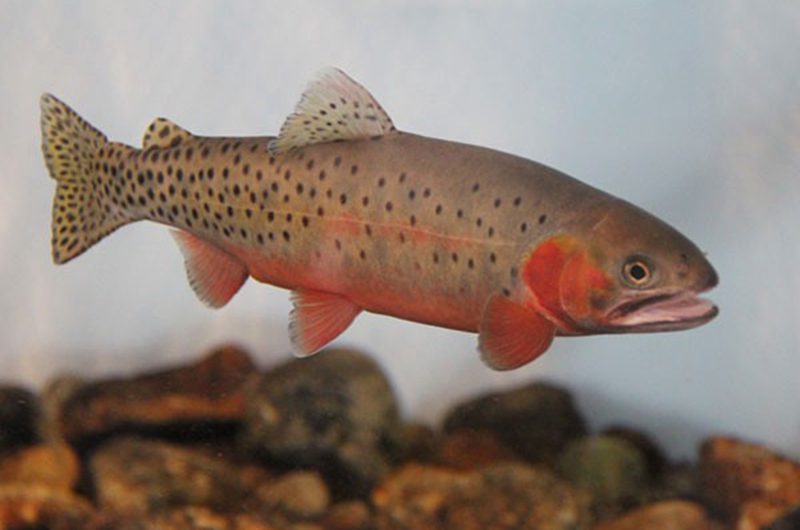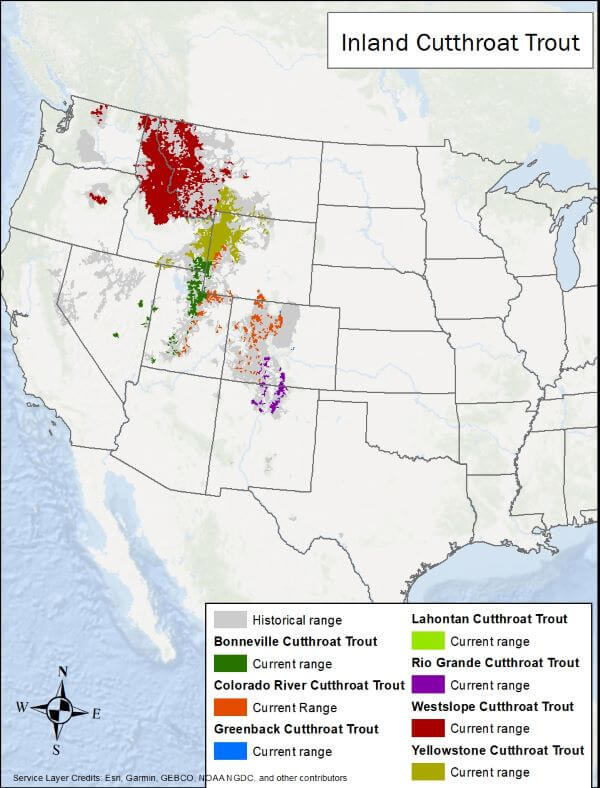LandPKS Learning
Habitat Hub

Inland Cutthroat Trout
Cutthroat trout inhabit clear, cold streams, rivers, and lakes with low fine sediment levels, well vegetated streambanks, and lots of instream cover.
Onocorhychus clarkii
Identification
Cutthroat trout are freshwater fish native to western North America and named for the two prominent red slashes beneath the jaws. The color is typically bright red. Cutthroat trout are lightly spotted, with fins heavily spotted. They have elongated bodies, and typically length is several times the width of their bodies. Mature fish are 6-22 in/15-55 cm in length and weigh 4-100 oz/113-2835 g. At least 12 existing and extinct subspecies of cutthroat trout are known, although there is debate on the exact number. Each subspecies vary greatly in size and appearance.
This factsheet and range map will cover seven inland subspecies: Bonneville, Colorado River, Greenback, Lahontan, Rio Grande, Westslope, and Yellowstone cutthroat trout. Bonneville cutthroat trout are found in the Bonneville Basin of Nevada, Utah, Idaho, and Wyoming, with nearly 300 populations. Colorado River cutthroat trout inhabit tributaries of the Green and Colorado Rivers. Greenback cutthroat trout is the easternmost subspecies and historically was native in tributaries of the Arkansas and South Platte Rivers. Currently, greenback cutthroat are being reintroduced into isolated streams within the Cache la Poudre River basin. Lahontan cutthroat (including Humboldt) inhabit the Lahontan Basin and Sierra Nevada in California, Nevada, and Oregon. Rio Grande cutthroat trout inhabit tributaries of the Rio Grande River. Westslope cutthroat trout is native to northern Idaho, Montana, British Columbia, and Alberta. Yellowstone cutthroat trout inhabit the upper Snake, Yellowstone River and Lake. Greenback and Lahontan cutthroat trout are all listed as Threatened in the United States, and Westslope cutthroat trout is designated as Threatened in British Columbia, Canada.
Observation Tips
Cutthroat trout are found in headwater streams across the western United States. Check with local Game and Fish Departments to find out where they are located. Inland populations spawn March-early July.
Interesting Fact
The first North American trout recorded by Europeans were cutthroat trout. Coronado’s expedition found these fish near Santa Fe, New Mexico, in 1541.
Ideal Habitat
Cutthroat trout inhabit clear, cold streams, rivers, and lakes with low fine sediment levels, well vegetated streambanks, and lots of instream cover. Tree canopy cover (>30%) and shrub cover (>50%) maintain shade and moderate stream temperature and promote channel stability. Cutthroat trout require complex hiding cover in the form of large wood, overhanging vegetation, undercut banks, boulders, and pools.
They are currently found in isolated headwater streams where hybridization with nonnative trout, especially rainbow trout, is controlled. Cutthroat trout are opportunistic feeders within and just downstream of riffles where aquatic invertebrates (mayflies, stoneflies, and caddisflies), small fish, and zooplankton are abundant. In fall and winter, deep pools that do not freeze and boulders for juveniles to escape predators are needed. Densities of cutthroat trout at a given location are primarily dependent on stream size and morphology, overwintering habitat, stream productivity, and hiding cover.

Range map provided by Trout Unlimited. Note: Historic range for all subspecies has been combined.
Management Activities that Benefit Species – Best Management Practices (BMPs)
Maintain isolation of existing cutthroat trout populations to prevent hybridization, predation, and competition with introduced trout and other nonnative fish species. Soil erosion and increased fine sediment in streams, as well as stream channel instability, impact trout habitat. If sediment enters the stream from cropland, road construction or maintenance, planting or expanding plantings or buffer strips can reduce erosion and sediment transfer.
Reduce barriers to cutthroat trout movement by installing fish passage around dams and diversion structures. Incentives and funding are available to improve habitat quality and connectivity for cutthroat trout, especially the subspecies that are listed as Threatened. Improving riparian vegetation structural diversity can help improve stream temperatures, provide hiding cover and undercut banks, and provide wildlife habitat. Improving vegetation can occur through planting native willows, other native species or controlling livestock use by installing riparian fencing.
Management Activities to Avoid
Avoid fragmentation of habitat through water diversions and other barriers to fish passage and removal of riparian vegetation. Many land uses, including timber harvesting, roads, residential development, mining, and agriculture, can degrade trout habitat. Avoid introducing nonnative fish, especially trout, into streams and lakes with cutthroat trout.
Other Species that Benefit from Similar Habitat Management
Managing for cutthroat trout habitat can benefit many other riparian and aquatic wildlife, including neotropical migratory birds.
Download
Download the Inland Cutthroat Trout factsheet
Descarga la ficha de la trucha degollada
Other Resources
NatureServe. 2021. NatureServe Explorer: An online encyclopedia of life [web application]. Version 7.1. NatureServe, Arlington, Virginia. Oncorhynchus clarkii; Bonneville; Colorado River; Greenback; Lahontan; Rio Grande; Westslope; Yellowstone
NRCS. Cutthroat trout. Fish and Wildlife Management Leaflet Number 47.
USFWS. ECOS Database Cutthroat trout subspecies websites can be searched for here
Trout Unlimited. 2019. Trout Unlimited Mapping Resources. Available at https://www.tu.org/science/science-engagement/interactive-maps/
Mobile App | Data Portal | Knowledge Hub | Habitat Hub | Learning Collections | Blog | About | Contact | Support



